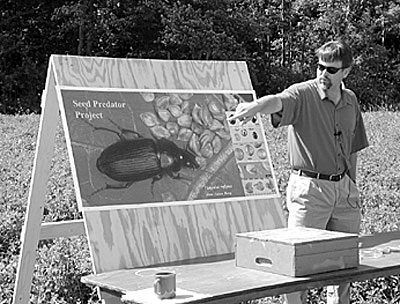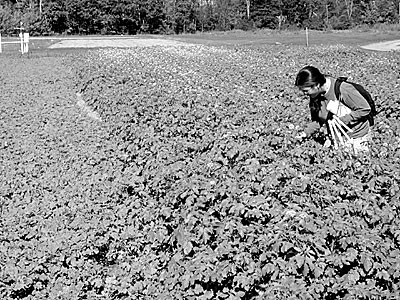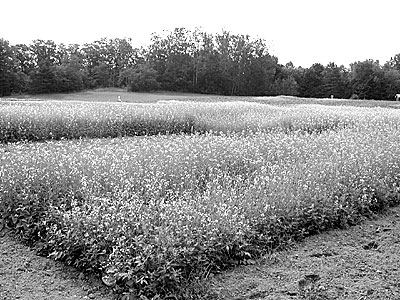 |
| Eric Gallandt, Assistant Professor of Weed Ecology and Management, University of Maine Sustainable Agriculture Program, at the 2002 Rogers Farm Field Day, discussing a recently initiated research project studying invertebrate weed seed predators in contrasting cover crop environments. Photo courtesy of Eric Gallandt. |
Kristan Doolan says that she, along with her husband George van Vlaanderen, attended the University of Maine’s graduate school program in sustainable agriculture because they wanted to be farmers. Kristan and George, who operate Doe’s Leap goat dairy near East Fairfield, Vermont, are somewhat unusual among graduates of the University’s graduate program, most of whom take up careers in other aspects of agriculture, but they are not unique when it comes to the University’s larger undergraduate program in sustainable agriculture.
“The undergraduate program has about 22 to 27 students in it, and about a third of those students are interested in some sort of farming after graduation,” says Eric Gallandt, a professor of weed ecology and management at the University of Maine and the advisor to the program for graduate students.
Both the graduate and undergraduate programs are farmer friendly. Undergraduates are required to have actual field experience on a farm, or with an organization working with farmers, such as MOFGA, before they graduate. Graduate students’ research tends to lean toward applied and practical rather than theoretical, according to Gallandt. To make his point, he refers to the work that graduate student Erin Haramoto is doing. “Erin is working on a project looking at Brasicca green manures,” he says. “The general idea is that Brasiccas can take these pungent, volatile compounds and they break down into another group of compounds, which have somewhat general biocidal properties. People are interested in this as a biological approach to fumigation for soil-borne diseases that are difficult to manage, but also they could have some benefits from managing weeds.”
 |
| Erin Haramoto, a graduate student in the University of Maine Sustainable Agriculture Program, examines flowering ‘Idagold,’ a condiment mustard being studied as a green manure for possible management of weeds, soil-borne pathogens and insect pests. Photo courtesy of Eric Gallandt. |
Gallandt says that most Brassicas, such as broccoli or canola, have the pungent compounds bred out of them. For his and Haramoto’s research, he turned to mustard varieties used for food condiments. Haramoto’s research focuses on the condiment mustard’s effects on weeds. “Karen’s project asks [whether] you have fewer weeds emerging as you plow in these mustard crops, and with the weeds that do emerge, are they less competitive,” Gallandt says.
Haramoto, as with many graduate students, does some of her work on the University’s research farm, but during the summer of 2003, she also ran trials on four Maine farms. Potatoes will be planted in those fields during the 2003 season. Gallandt says he and Haramoto are asking technical questions that may interest only scientists initially, but the farm trials give Haramoto’s research a strong practical twist. “If these things work, they will be immediately deliverable to farmers,” he says.
Gallandt works with his graduate students so that they can coexist in two somewhat different communities. “I try to make sure that I, as well as my students, can speak in front of a group of weed ecologists as well as a group of farmers,” he says.
Undergraduate students in the University’s sustainable agriculture program not only get to speak to farmers and work on farms during their required session of field study; they actually can manage a farm. The Black Bear Food Guild is a CSA farm with 40 to 50 subscribers. Its crops come from land rented by students on the University’s research farm.
 |
| A field shot of Erin’s research plots, where she is studying the effects of incorporated Brassica green manures on weed emergence and weed/crop competition. Photo courtesy of Eric Gallandt. |
“The Guild arose from a strong desire from a few undergraduates who really wanted to farm [and] who felt they weren’t getting enough practical experience,” says Gallandt, who works with undergraduate advisor Marianne Sarrantonio to provide a light-handed oversight for the Guild. “The students built it and they run the show. It’s a huge responsibility they take on and a great learning experience.”
Whether graduate or undergraduate, and whether or not they choose to become farmers, students participating in the sustainable agriculture program likely will hear a consistent and repeated message about what sustainable agriculture is. “The philosophy of sustainable agriculture that joins the faculty here together is the idea of an agriculture that relies more on internal processes and the ecology of the agricultural system and more on management and less on things that need to be purchased,” Gallandt says. “It’s a more self reliant agriculture that is beneficial to the farm and the environment. It supports practices that improve the ecological capital of the farm, such as the soils, and maintains the financial stability of the farm so it can be passed down through the generations.”

